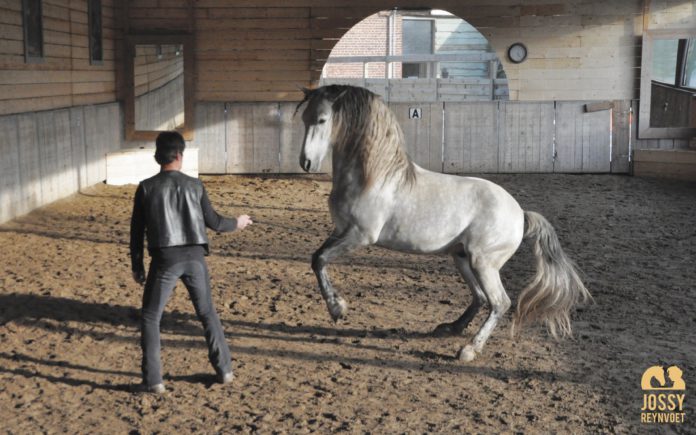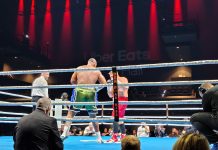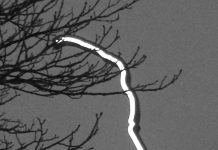
Frankfurt, Germany (Weltexpress). Born in 1963 Jossy Reynvoet is concerned with horses passionately and dreamt early in his youth of a horse in an open plain, galloping in complete freedom, without bridle, without saddle.
With 16 years he became a showjumper and the aspect of “winning” and everything around prevailed above the comfort of the horses till later his daughter brought him back to his dream.
Since 1993 he searched and looked for the answers for all his questions about bitless riding and he discovered some beneficial factors such as food, body language, prey and herd instinct.
Since 2000 he had his own business where he coaches horses and riders in a natural way.
In 2007 he met, Pascale, his wife. She took over the administrative part so he could focus completely on horses in every way.
Since February 2013 he became a Bent Branderup trainer.
In 2014 he developed the bitless bridles, called cavemore and cavesal.
Jossy Reynvoet has now put together a concept to ride without bit. During the week, he teaches individually, at weekends he teaches groups in Belgium and abroad.
The aim is giving people and horse mutual trust so riding can be fun and not a competition.
The training of young or traumatized horses is also possible.
* * *
Bernd Paschel: Dear Jossy, let’s talk about jumping because I had a similar entry as you had in riding as a competitor in the modern pentathlon. To win was in the foreground. Riding was for us recreation in comparison to the other disciplines of the pentathlon, because the main work done the horse. Is “art” the better term, especially the dressage?
Jossy Reynvoet: Dressage is meant for the healthy of the horse and not the horse is meant for dressage. It is not about exercises anymore and not about competition. The horse is in the center and the goal is to make him stronger and to give him time.
Bernd Paschel: The academic question should be less important than the welfare and communication with horses. I hope you agree with me? Let’s talk about bitless riding you started early 1993 before Dr. Cook published the results of his scientific research. You really are a pioneer.
Jossy Reynvoet: In a certain way you are right but nothing can bee seen independent from each other. For me, the welfare of the horse is very important but I am a horseman who wants to ride. You can not do it without knowledge about biomechanics for the welfare of the horse. When I was a young boy I had to catch ponies for my father when he was a horse seller. I used ropes or no bridle at all. I even rode them sometimes without anything in the field. We had no bridles, no saddles, no teacher in that time. It was fun. Later as a jumping rider I often had difficult horses, they were tense because of the competition energy. Often I took out their bit and trained them like that. I realised they were more focused on me and more relax. I stopped show jumping in 1992 and after a break of one year I wanted to find the joy back from my childhood. Someone offered me a horse called “Raisa”, a chestnut mare. The seller said that that horse would never be able to be ridden without a bit because of her very strong character. I looked her in the eyes and said to her “if you allow me to ride you without a bit than I will never use a bit anymore in my entire life”. And magic happened. She allowed me to ride her without a bit and she never showed a bad character. She was a fantastic horse. With her I started to give my first demo’s. So I still keep my promise.
Bernd Paschel: This is a beautiful story. Many bitless-horsemen consider , that the bit is necessary for certain lections in dressage. If I understand you right, meanwhile your horses never see a bit?
Jossy Reynvoet: Exactly, it is my goal to reach the highest level in dressage without a bit for the welfare of the horse. It is never too late to start without a bit but “bitless art is only an art when it is bitless from the start”. My young stallions, all between 8 and 10 years old have never seen a bit. I go out with them in the traffic, fields, woods… everywhere.
Bernd Paschel: In my opinion the biggest human problem is the fear of loosing control and that is a vicious circle. I do not want to speculate about the pathological fear of losing control but that to admit will be often understood as a defeat!
Jossy Reynvoet: Through the years horses proved that they can connect with a human like a real friend. By knowing this I choose to work out of friendship with them instead of controlling them with a bit. I prefer to cooperate with a horse in a logical structure that they can understand. It takes maybe longer but you get so much more authenticity. I will never tell people to take the bit out and to ride without a bit. You first have to work on your togetherness with physical and optical communication.
Besides… many horses proved also that they can not be controlled with a bit
Bernd Paschel: Your horses have no iron on the hoof, they living in groups, they are not overfed. I believe you do all right. It seems to me there is no more to talk about. Can you understand, that people stop to mountain the horse? Sometimes I’m not sure, if my horse like my heavy weight of 70 kg every day?
Jossy Reynvoet: Yes, you are right. I believe not every horse is well build enough to carry a rider. That is something we should now. But if the horse has a good body shape and he is well trained than he can carry a human. But also here it takes time and it has to be build up. Futhermore it is also important that people should not be too havy and souple and movable enough. Not every horse is a rider horse and we should know that not every human is a rider because of this weight and movability problems.
Bernd Paschel: Does a horse need a special training for his health, when it is living on a large meadow, with other horses, 24 hours of free running?
Jossy Reynvoet: As long as you do not to want to ride your horse it is okay to leave him in the meadow with good food. But as soon as you want to ride you need biomechanics, gymnastic and collection to develop the right muscles for carrying you. The horse should be prepared from the ground.
Bernd Paschel: In humans, health-training is a combination of a moderate training of endurance and strength / agility, with the focus on endurance especially in old age. Is not that the same with horses?
Jossy Reynvoet: Yes it is the same.
Bernd Paschel: If I may continue the discussion thread: Well-developed muscles stabilize joints.
Jossy Reynvoet: A good dressage horse has strong but also flexible muscles. What we do is training the horse from the ground, so we will have feed back from the horse when it is really ready to be a good riding horse.
Bernd Paschel: I now switch off competitions in dressage riding on television because I no longer bear the tense horses with the drooling mouths. It is also the case with jumping, especially in jump-off, when you see wild tearing at the rein with good riders. A horse with a blue tongue should be immediately disqualified.
Jossy Reynvoet: To the latter I agree, but I believe when ego, competition and money is involved it is a pitty for the horse. The horse is the victim. It is so nice to work with a horse, to come together with a horse when you have knowledge, time and you can let go your ego and have ampathy with the horse. Once again, the horse is in the center. I put no “time” on how fast my horse wil develop. I develop my horse and he will tell me when it is time.
Bernd Paschel: In a sports science article I was able to read that a load of a fast gallop over 300 m daily should be done to train the joints.
Many box-horses do not reach this by far and are therefore probably also very susceptible to joint problems?
Jossy Reynvoet: Joints do not grow like muscles, but they become slowly firmer with adequate training. And yes it is important that your horse canter about 300m a day and this 4 to 5 times a week for making the joints stronger. I did not know anything about the sport sience article but it is my experience that horses need this canter to stay flexible and movable. Canter provides also more roundness in the topline.
Bernd Paschel: I have one last question: Do I need more riding skills without a bit in a comparable dressage than with a bit?
Jossy Reynvoet: No, you do not need more riding skills to a comparable dressage without a bit . Nevertheless it is important that you develop your riders skills when you want to ride for the welfare of the horse. For me the horse is the judge and not the human. The horse can judge you when you ride him bitless because he has always a fair meaning. But you need more awareness and the horse will give you feedback and tell you when he can become a rider horse. So that also means that you need more knowledge about how making your horse a riding horse. For me it is not all about rider skills. It is also about stable management, osteopathy and psychology.
Bernd Paschel: Thank you, dear Jossy, for your instructive words, which makes curious to look more intensely on the subject of “shaping the dressage horse” on the basis of the bitless riding, which, as is known, is prohibited by the rules in the competition of the Equestrian Federations.
* * *
Further informations: http://www.bitless-art-of-riding.com



















